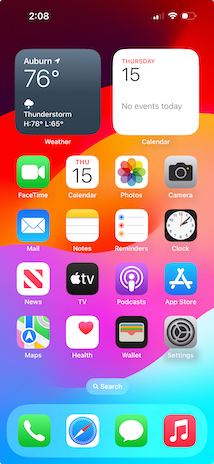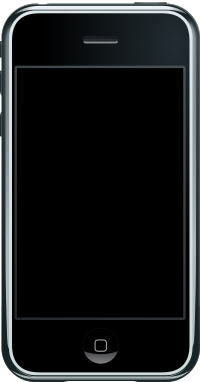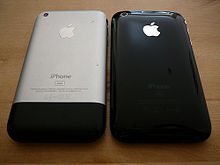
The iPod Nano is a discontinued portable media player designed and formerly marketed by Apple Inc. The first-generation model was introduced on September 7, 2005, as a replacement for the iPod Mini, using flash memory for storage. The iPod Nano went through several models, or generations, after its introduction. Apple discontinued the iPod Nano on July 27, 2017.

The Nokia N95 is a mobile phone produced by Nokia as part of their Nseries line of portable devices. Announced in September 2006, it was released to the market in March 2007. The N95 ran S60 3rd Edition, on Symbian OS v9.2. It has a two-way sliding mechanism, which can be used to access either media playback buttons or a numeric keypad. It was first released in silver and later on in black, with limited edition quantities in gold and purple. The launch price of the N95 was around €550.

The iPhone is a line of smartphones produced by Apple that use Apple's own iOS mobile operating system. The first-generation iPhone was announced by then–Apple CEO Steve Jobs on January 9, 2007. Since then, Apple has annually released new iPhone models and iOS updates. As of November 1, 2018, more than 2.2 billion iPhones had been sold.

The iPod Touch is a discontinued line of iOS-based mobile devices designed and formerly marketed by Apple Inc. with a touchscreen-controlled user interface. As with other iPod models, the iPod Touch can be used as a portable media player and a handheld gaming device, but can also be used as a digital camera, a web browser, for email and messaging. It is nearly identical in design to the iPhone, and can run most iPhone third-party apps from the App Store, but it connects to the Internet only through Wi-Fi and uses no cellular network data, as it lacks a cellular modem.
Amazon Kindle is a series of e-readers designed and marketed by Amazon. Amazon Kindle devices enable users to browse, buy, download, and read e-books, newspapers, magazines and other digital media via wireless networking to the Kindle Store. The hardware platform, which Amazon subsidiary Lab126 developed, began as a single device in 2007. Currently, it comprises a range of devices, including e-readers with E Ink electronic paper displays and Kindle applications on all major computing platforms. All Kindle devices integrate with Windows and macOS file systems and Kindle Store content and, as of March 2018, the store had over six million e-books available in the United States.

iOS is a mobile operating system developed by Apple Inc. exclusively for its smartphones. It was unveiled in January 2007 for the first-generation iPhone, launched in June 2007.

The Nokia E71 is a mobile phone introduced on 8 May 2008 from the Eseries range with a QWERTY keyboard targeting business users worldwide. It runs on Symbian OS v9.2, with a Series 60 3rd Edition, second generation Feature Pack 1. The Nokia E71 succeeded the Nokia E61/61i models, building on the base design and form factor but enhancing on the feature set.
iOS is a mobile operating system developed by Apple Inc. and was first released as iPhone OS in June 2007, coinciding with the launch of the first generation iPhone. iPhone OS was renamed iOS following the release of the iPad, starting with iOS 4. With iOS 13, Apple began offering a separate operating system, iPadOS, for the iPad. iOS is also the foundation of the newer audioOS and tvOS, and shares some of its code with macOS. New iOS versions are released every year alongside new iPhone models. From its launch in 2007 until 2010, this occurred in June or July, since then, new major versions are released in September or October. Since the launch of the iPhone in June 2007, there have been 17 major releases of iOS. The current major version of iOS is iOS 17, released on September 18, 2023.
iOS jailbreaking is the use of a privilege escalation exploit to remove software restrictions imposed by Apple on devices running iOS and iOS-based operating systems. It is typically done through a series of kernel patches. A jailbroken device typically permits root access within the operating system and provides the right to install software unavailable through the App Store. Different devices and versions are exploited with a variety of tools. Apple views jailbreaking as a violation of the end-user license agreement and strongly cautions device owners not to try to achieve root access through the exploitation of vulnerabilities.

The iPhone 3GS is a smartphone that was designed, developed, and marketed by Apple Inc. It is the third generation iPhone and the successor to the iPhone 3G. It was unveiled on June 8, 2009 at the WWDC 2009 which took place at the Moscone Center in San Francisco.

The iPhone 4 is a smartphone that was designed, developed, and marketed by Apple Inc. It is the fourth generation of the iPhone lineup, succeeding the iPhone 3GS and preceding the 4S. Following a number of notable leaks, the iPhone 4 was first unveiled on June 7, 2010, at Apple's Worldwide Developers Conference in San Francisco, and was released on June 24, 2010, in the United States, United Kingdom, France, Germany, and Japan. The iPhone 4 introduced a new hardware design to the iPhone family, which Apple's CEO Steve Jobs touted as the thinnest smartphone in the world at the time; it consisted of a stainless steel frame which doubled as an antenna, with internal components situated between two panels of aluminosilicate glass. The iPhone 4 introduced Apple's new high-resolution "Retina Display", while maintaining the same physical size and aspect ratio as its precursors, Apple's A4 system-on-chip, along with iOS 4—which notably introduced multitasking functionality and app folders. It was the first iPhone at the time to include a front-facing camera, which made possible Apple's new FaceTime video chat service, and the first to be released in a version for CDMA networks, ending AT&T's period as the exclusive carrier of iPhone products in the United States.

iOS 4 is the fourth major release of the iOS mobile operating system developed by Apple Inc., being the successor to iPhone OS 3. It was announced at the Apple Special Event on April 8, 2010, and released on June 21, 2010. iOS 4 was the first version branded as "iOS" rather than "iPhone OS", due to the release of the iPad. It was succeeded by iOS 5 on October 12, 2011.

The iPhone is the first iPhone model and the first smartphone designed, developed, and marketed by Apple Inc. After years of rumors and speculation, it was officially announced on January 9, 2007, and was released in the United States on June 29, 2007.

The iPad 2 is a tablet designed, developed and marketed by Apple Inc. Compared to the first iPad, as the second model in the iPad line, it gained a faster dual core A5 processor, a lighter build structure with a flat, rather than curved, back, and was the first iPad to feature VGA front-facing and 720p rear-facing cameras designed for FaceTime video calling.

The iPhone 4s is a smartphone that was designed, developed, and marketed by Apple Inc. It is the fifth generation of the iPhone, succeeding the iPhone 4 and preceding the iPhone 5. It was announced on October 4, 2011, at Apple's Cupertino campus, and was the final Apple product announced in the lifetime of former Apple CEO and co-founder Steve Jobs, who died the following day.

iPhone OS 2 is the second major release of the iOS mobile operating system developed by Apple Inc., being the successor to iPhone OS 1. It was the first version of iOS to support third-party applications via the App Store. iPhone OS 2.2.1 is the final version of iPhone OS 2. It was succeeded by iPhone OS 3 on June 17, 2009.

iPhone OS 3 is the third major release of the iOS mobile operating system developed by Apple Inc., succeeding iPhone OS 2. It was announced on March 17, 2009, and was released on June 17, 2009. It was succeeded by iOS 4 on June 21, 2010, dropping the "iPhone OS" naming convention.

The iPad Air 2 is the second-generation iPad Air tablet computer designed, developed, and marketed by Apple Inc. It was announced on October 16, 2014, alongside the iPad Mini 3, both of which were released on October 22, 2014. The iPad Air 2 is thinner, lighter and faster than its predecessor, the first-generation iPad Air, and features Touch ID with the height, width and screen size the same as the iPad Air.

The third generation iPod Touch is a multi-touch mobile device designed and marketed by Apple Inc. with a touchscreen-based user interface and is the successor to the 2nd-generation iPod Touch. It was unveiled and released at Apple's media event on September 9, 2009.
The iPhone's hardware is designed by Apple Inc. Apple directly sub-contracts hardware production to external OEM companies, maintaining a high degree of control over the end product.

















